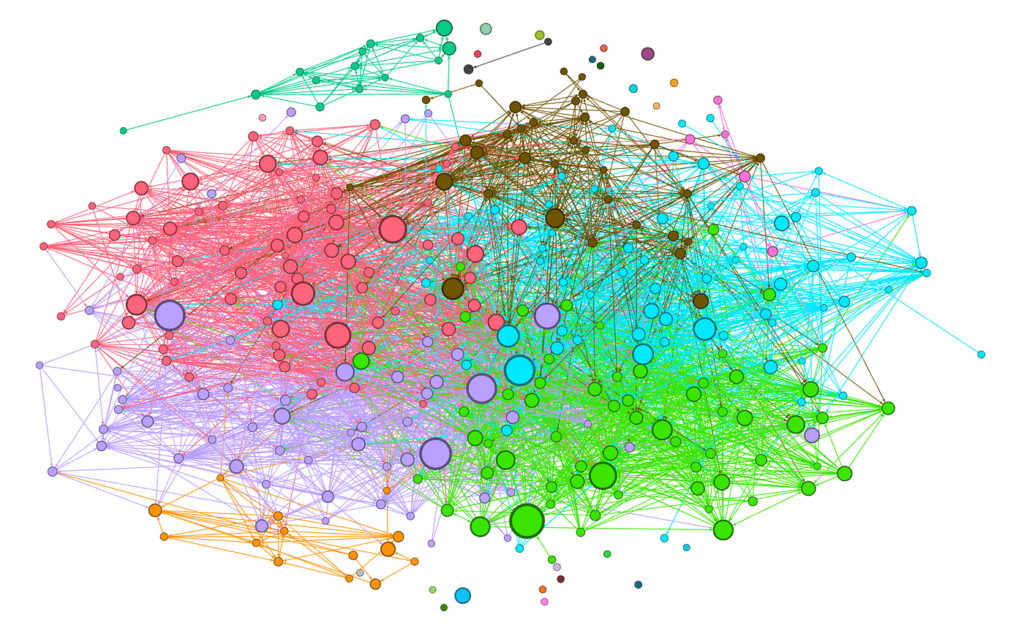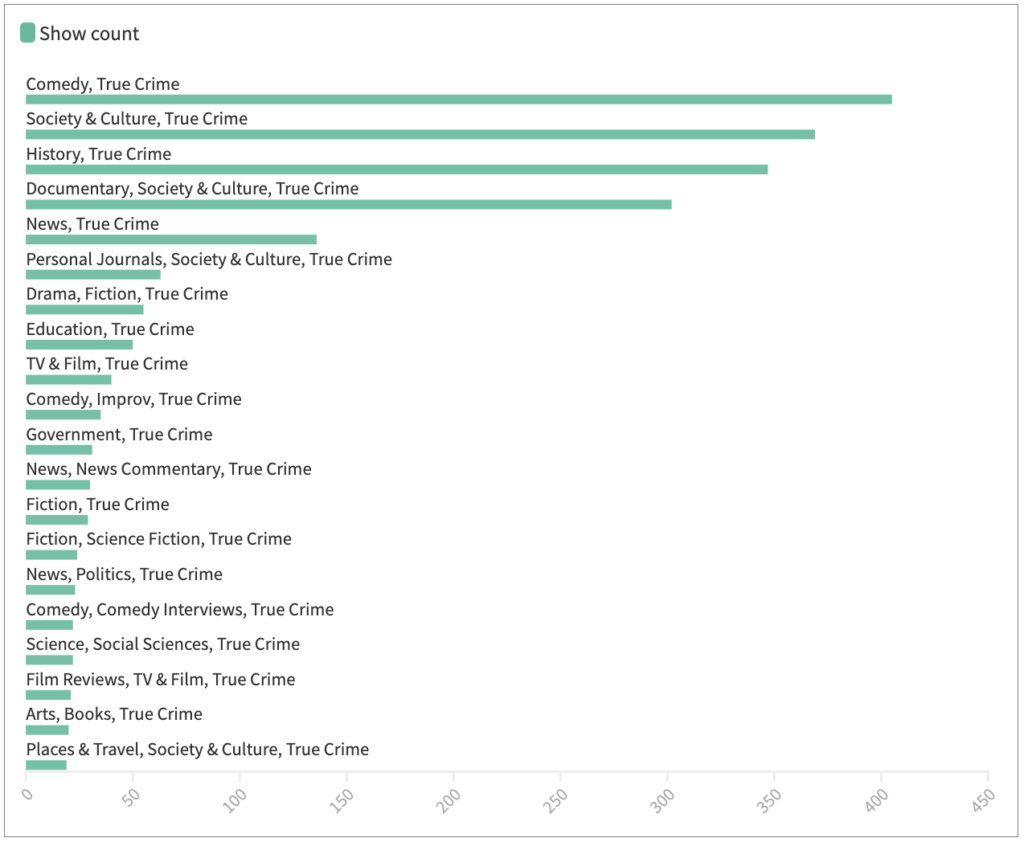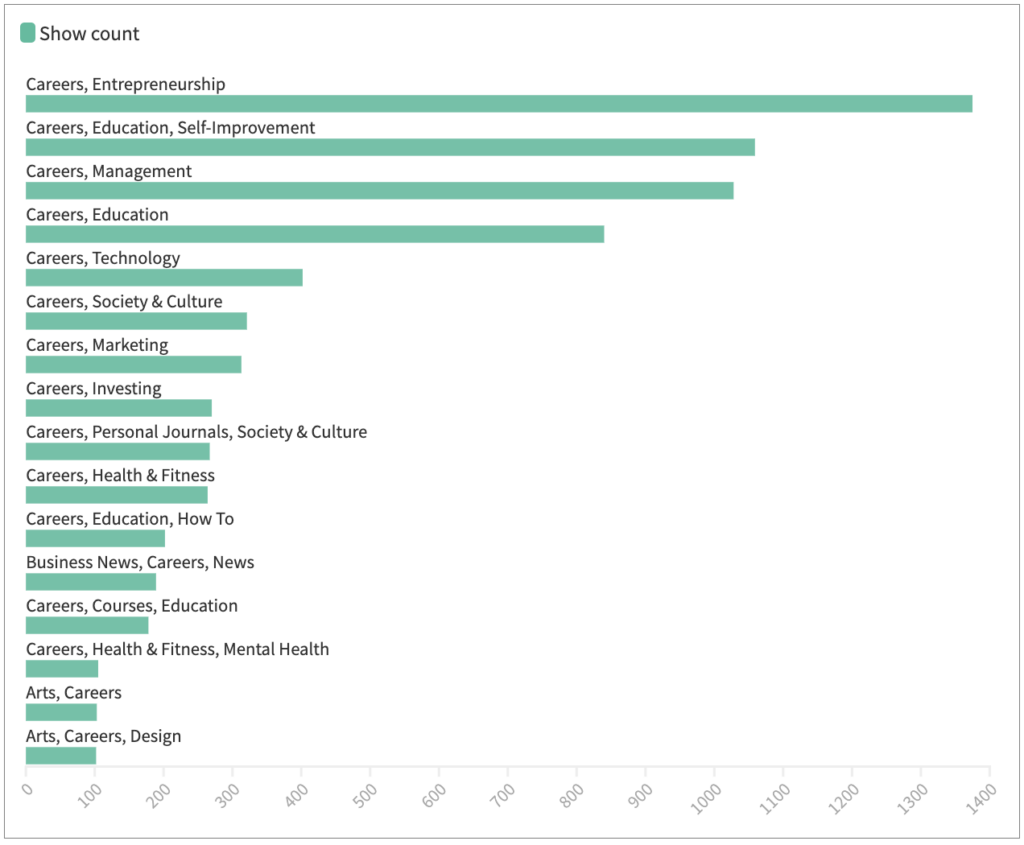The mysterious case of the overlapping Apple Podcasts categories

Last week, I met with a group of true crime podcasters. They were working on a new season of their show, so we wanted to better understand the true crime podcast landscape.
We started by looking at a true crime podcast neighborhood:

As we explored the neighbourhood, we were struck by the breadth of the genre, and all the different “flavours” of true crime contained within. For example, we spotted:
- Documentary-style investigations with original reporting
- True crime buddycasts (AKA “Wikipedia and a bottle of wine”)
- Paranormal and supernatural true crime
- Violent true crime
- Non-violent true crime
- Location-specific true crime (e.g. Canadian True Crime)
… and many more.
It can be difficult to wrap your head around true crime podcasts, partly because the category includes so many different types of shows. Despite this wide variety, all 10,000 true crime shows get lumped together into one big True Crime bucket.
So I got curious.
Aside from podcast neighbourhoods, how could I find a way to segment a broad genre like true crime into more manageable pieces to better understand the competitive landscape?
Turns out, there are clues hidden inside every podcast’s metadata. 🔍
The value of assigning multiple categories
Every podcaster can assign their show one (or more) of Apple’s 100+ categories. Apple says:
You can choose up to two categories or subcategories that best reflect the content of your show. The primary category is used to display your show in each category page, Top Charts, and personalized recommendations in Listen Now. The secondary category also helps your show appear in select category pages, in editorially curated collections, and in search.
Interesting.
True Crime is a broad genre. Not always useful on its own.
But if a show is categorized as True Crime + Comedy, well, that tells me something interesting and useful and could help me make a decision as a listener.
And if a show is categorized as True Crime + History, that tells me something very different about the type of stories I might expect to hear.
It’s not quite at the Netflix level of categorization, but these secondary categories can certainly help disambiguate podcasts.
Crunching the numbers
I wanted to understand the relative popularity of various combinations of categories among true crime shows in Apple Podcasts.
So I collected metadata for 9,536 shows listed in Apple’s True Crime section and counted all the combinations of various categories.
Unsurprisingly, many podcasters choose a single category and call it a day without specifying any additional categories. 75% of the True Crime shows in Apple Podcasts list True Crime as their only category. But many shows go farther, and specify secondary categories:

“Comedic true crime” feels distinct from “historical true crime.” Which in turn feels distinct from “news-flavoured True Crime.”
I was slightly perplexed by the Fiction + True Crime shows. But then I remembered this.
This works on other categories, too
Of course, this approach — breaking down a podcast category by examining secondary categories — works well outside true crime, too.
For example, Pacific Content works with the Environmental Defense Fund and Podcast Allies on Degrees: Real talk about planet-saving careers. It’s a show about careers and sustainability, and as such, its primary category is Careers.
But Careers is a big, broad category, with nearly 30,000 shows. Indeed, many of the shows on the Apple Podcasts Careers chart are broad and of general interest. If you’re looking for a show about careers in, say, nutrition, that’s very different than a show about careers in marketing, or technology, or education.
If you’re looking for a careers podcast related to a specific industry, the Careers category in Apple Podcasts is so broad it borders on unhelpful.
But thanks to podcasters who’ve assigned secondary categories to their show, we can see the breakdown of various career-focused series:

Unsurprisingly, Careers +Entrepreneurship is the most popular combination of categories, but there’s a lot of variety father down the list.
Presumably, a show categorized as Careers + Education is meant for a different audience than a show categorized as Careers + Management.
A wish 🤞
The more I dug into this data, the more I wish that secondary categories were more visible to listeners.
Under the hood, many podcast feeds contain more than one podcast category. For example, Inside the Breakthrough identifies Science as its primary category. But it’s also a show about History, told in a Documentary format. The show’s RSS feed reflects that:
<itunes:category text="Science"/>
<itunes:category text="History"/>
<itunes:category text="Society & Culture">
<itunes:category text="Documentary"/>
</itunes:category>
However, many podcast apps (most notably Apple Podcasts) only display the show’s primary category:

Wouldn’t it be great if podcast apps meaningfully exposed secondary categories to listeners? Wouldn’t it be great to search for (and discover) shows based on the intersection of categories?
That way, I could more easily search for podcasts at the intersection of Science + History.
Or I could find a list of shows that fit in Music + True Crime.
Or Technology + Swimming.
I’d love for some enterprising person to build a tool that could help me find shows at the intersection of multiple categories.
Remember
- Every podcaster can categorize their show into one (or more) categories
- Your podcast categories are an important part of your show’s product packaging
- If you’ve only specified a single primary category for your show, consider adding a secondary category. Even though they’re not prominently displayed, Apple Podcasts says secondary categories are used within their app.
Sign up for the Pacific Content Newsletter: audio strategy, analysis, and insight in your inbox.
